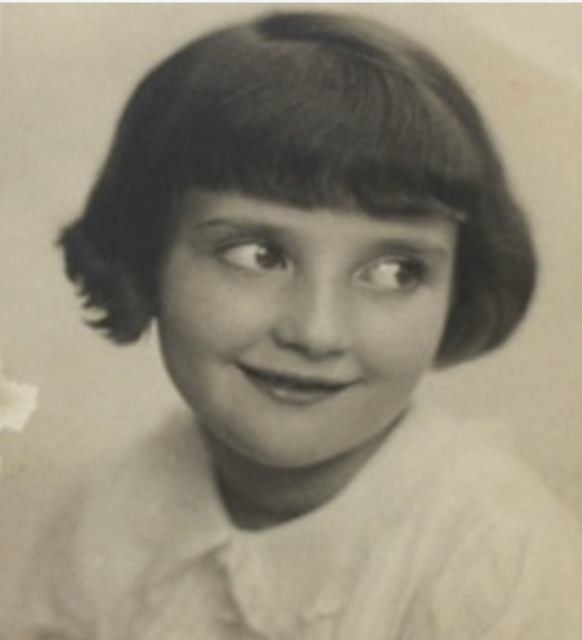Hamburg Stories Steffi Wittenberg (née Hammerschlag)
Karolinenstraße 35, 20357 Hamburg- Karolinenviertel

Steffi Hammerschlag experienced the early years of the Second World War as a pupil at the Israelite Girls School and survived thanks to a Uruguayan visa issued just in time. She left Germany with her mother in December 1939, one of the last opportunities to do so, and ultimately lived to be eighty-nine years of age.
Steffi (*1926) was already exposed to National Socialism as a first grader: at the time, everything was about winning and Germans had to be the best. You had to be ambitious at sport and at singing ons Monday a “beautiful Haydn melody” was ruined by the “awful lyrics” of “Deutschland, Deutschland über alles”. Six-year-old Steffi was a pupil of Hamburg’s Jahnschule when Adolf Hitler was appointed Reich Chancellor on 30 January 1933. Her mother, Margot Hammerschlag, told her anxiously:
“We Jews now have to leave Germany, we’re all going to be killed.”
In 1935, Steffi transferred to the Jewish Girls School in Karolinenstraße. There was a hairdresser and a grocery in her neighbourhood. When the neighbours eventually found out that the Hammerschlags were Jewish, even the friendliest immediately stopped greeting them. Each time the SA troops and Hitler Youth marched through the streets singing “Wenn das Judenblut vom Messer spritzt” (When Jewish blood spurts from the knife) Steffi became more and more frightened. She never forgot what a non-Jewish acquaintance had said to her mother: “Ah Frau Hammerschlag, if only all Jews were like you, now the innocent have to suffer with the guilty.”
At a certain point, Steffi’s mother Margot realized they would have to leave Germany. Having failed to secure a visa in the consulates of South Africa, the Netherlands, USA and England, she discovered in 1938 that Uruguay was issuing visas for a small bribe. So Uruguay it was. The family was finally given four visas for Steffi’s father Franz Hammerschlag, her mother Margot, her brother Gerd and Steffi herself. “The men have to leave first!” said her mother. In October 1938, her husband Franz and her son Gerd left Germany for Uruguay. Margot Hammerschlag was to follow two months later with Steffi. But things turned out differently.

The situation came to a head in October 1938. In the so-called Polish action (Polenaktion), the Nazi regime deported Jews who had Polish passports to Poland. The family of Steffi’s close friend, star pupil Mirjam Friedfertig, was also affected. Mirjam said that her father was to be deported to Poland. The next day Mirjam was no longer there. Her whole family was sent to Poland from Altona railway station, along with a hundred other Polish Jews.
On the night of 9/10 November 1938, the Nazis set fire to synagogues and destroyed Jewish businesses throughout Germany. Over 30,000 Jews were arrested, more than a 1000 of them in Hamburg.
Twelve-year-old Steffi was on her way to school on 10 November when other children came towards her, saying that school had been cancelled that day and the synagogues were on fire. Steffi mader her way back. There was uproar at home, since word had spread that numerous Jewish men were arrested. Fortunately, Steffi’s father and brother had already arrived in Uruguay. Margot and Steffi Hammerschlag took two families, including the fathers, into their home and hid them: the Haas family and the Meyer family.
Since the teachers at Steffi’s school in Karolinenstraße were almost all female, none of them, including the school principal, were arrested. Steffi heard from other children, however, that teachers at their schools had returned to the school with shaved heads. They were limping, had facial injuries and looked enormously shocked.
From then on, Jewish life changed dramatically: Jews were forbidden to go to theatres, concerts, cinemas and museums; children were no longer allowed on the new ice rink; doctors and lawyers were not permitted to look after Jews. If you were Jewish you lost your job and most benches in parks had an “Aryans only” notice. Jewish women were given the additional name “Sara”, men the name “Israel”. Jewish passports were stamped with a red “J”.
In December 1938, when Steffi and her mother were ready to embark on their journey to Uruguay, their visas were suddenly declared invalid.

On 1 September 1939, German troops had invaded Poland, marking the beginning of the Second World War. Steffi saw her mother Margot crying in the living room.
“Now we won’t get out, we’ll all be murdered.”
Steffi comforted her and wrote in her diary that evening: “Today the Führer has called the Wehrmacht to arms, on Aunt Grete’s birthday of all days.” Later, Steffi found the sentence so banal that she threw her diary into the bin.
In November 1939, two months after the war began, Steffi’s mother received a telegram from her husband Franz. He had managed to organize new visas for his wife and daughter. Steffi and her mother travelled by train to Antwerp via Aachen in December 1939, where they finally boardedd a ship bound for Uruguay. This was one of the last opportunities for Jews to leave Europe. Almost all of the other passengers were Jewish. Many of them had been taken off the train in Aachen the day before and beaten. Steffi and her mother were lucky, nothing had happened to them on the journey. At the end of January 1940, their ship finally arrived safely in Montevideo, Uruguay, having crossed the mined English Channel.
In the course of eight years in Uruguay, Steffi met her husband, Kurz Wittenberg, who was highly active in the antifascist struggle. They married in 1948 and returned to Germany in 1951, to Hamburg, Steffi’s birthplace. Following their return, Steffi and Kurz Wittenberg worked for decades towards a better society, for the remembrance of Nazi injustices and for a vibrant memory culture.
Steffi Wittenberg died on 26 March 2015 in Hamburg at the age of eighty-nine.
Her old school is now the Israelite Girls School Memorial and Educational Centre. It houses a permanent exhibition on former Jewish school life in Hamburg. Her son, Andreas Wittenberg, regularly remembers his mother Steffi Wittenberg there.
(This text is based on a report by Steffi Witternberg’s grandson Henri Wittenberg, who is a school pupil and lives in Berlin.)



